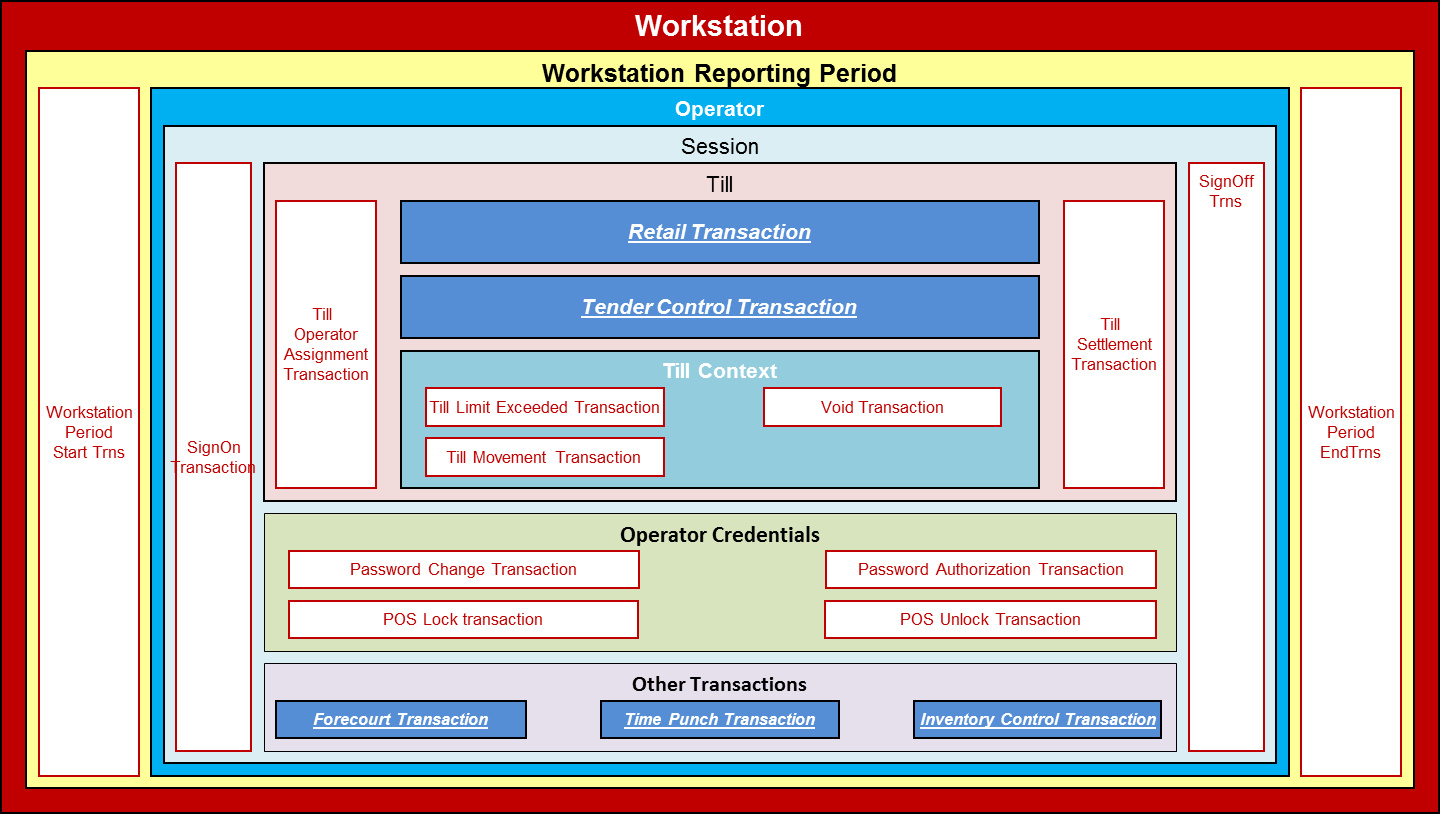Theme Concepts As discussed in the ARTS Transaction Concepts theme,ARTS ODM 7.0/7.1 has a generalized entity type that represents all point of sale transactions. This topic, as the title indicates addresses Control Transactions. Control transactions establish the technical and administrative context within which retail, tender control, forecourt and inventory control transactions may be created. Point of sale systems vary in how they present and implement control transactions but they all require them as a prerequisite to executing the aforementioned business transactions. With this contextual role in mind, the discussion below, while focused on control transactions, references the business transactions executed with the workstation reporting period, operator, session and till contexts. The ARTS ODM 7.0/7.1 has a Transaction entity type that is the "granddaddy" of all transactions. It is sub-typed into differentiated transaction entity types that include: •Retail Transaction - business oriented transaction type that captures sales and return settlements and POS initiated customer orders; •Access Control Transactions - monitor and control access to retail information resources (primarily point of sale systems); •Operator, Workstation and Session Control Transactions - monitor and control operator activities, workstation activities and session activity at a transaction level; •Void Transactions - monitor and control transactions that reverse earlier transactions (voids); •Override Transactions - monitor manager and other actions to supersede retailer point of sale enforced rules; and •Tender Control - business oriented transaction type to monitor and track the receipt, movement and disposition of tender throughout the retail enterprise with an emphasis on store-level control. Retail Transactions and Tender Control and Audit Transactions, as suggested by the hyperlink font are covered under their own topics. The middle four transaction functional areas are covered here as control transactions. The diagram below illustrates the different kinds of transactions represented in the ARTS ODM V7.0/7.1 data model. The dark blue blocks with underlined, italic text are business oriented transaction types discussed in detail under different topics and can be linked to for further information. The white blocks with red lettering represent control transactions are are discussed in the subject areas under this theme. The diagram is useful because it shows how the different transaction types establish process boundaries for different point of sale operations. For example, retail transactions can only occur within the context of a workstation -> workstation reporting period (usually a business day) -> operator -> session -> till. The concentric blocks establish transactional contexts. Each context is established by a starting control transaction and closed by an ending transaction (e.g. a end or period, sign off, till settlement or retail transaction posting). Figure 63 - ARTS Transaction Context and Transaction Types |

The "Other Non-control", business-oriented transactions are additional point of sale services supported in the ARTS Data Model. They may be linked to by clicking on their blocks. Workstation Reporting Period ContextThe outer-most context is the Workstation Reporting Period. A Workstation Reporting Period context is instantiated by completing the Workstation Period Start Transaction. It is basically turning a point of sale workstation on, loading the operating system and application and making it ready to accept an operator sign on. A workstation Reporting Period context is a prerequisite to initiating all other point of sale transactions. Session & Till ContextControl transactions are primarily designed to capture point of sale operator access to resources. The typical cashier can only operate within a workstation period -> session -> operator -> till context. The reach that context the operator will invoke two kinds of control transactions within a Workstation Reporting Period Context. The first kind of control transaction establishes a session context through signing on to the workstation. The second kind of control transaction binds an operator to a specific cash drawer (till) which they are responsible for when entering sales and returns and accepting and paying out tender. The Till Settlement Transaction represents the closing out of a till and the termination of an operator -> till context. The sign-off transaction terminates a session context. The Workstation Period End Transaction represents the termination of a Workstation Period Context and is typically associated with a daily closing procedure. An operator may execute several kinds of transactions while their till context is "alive". These include: •Retail Transactions (sales, returns and tender processing which are the bulk of transactions handled by a point of sale operator); •Tender Control and Audit Transactions (these are control transactions used to monitor, manage and handle tender out of balance conditions); •Till Limit Exceed Transaction - an automatically initiated control transaction that is invoked when a till on hand tender balance reaches or exceeds a retailer set limit; and •Till Movement Transaction - a control transaction that tracks the physical movement of tender between a till (cash drawer), the store safe and external depositories. In addition to these till-context control transactions, operators may invoke: •Password change transactions; •Password authorization transactions; and •POS lock/unlock transactions. These are resource access-related control transactions used to identify, authorize and authenticate workstation operators. |